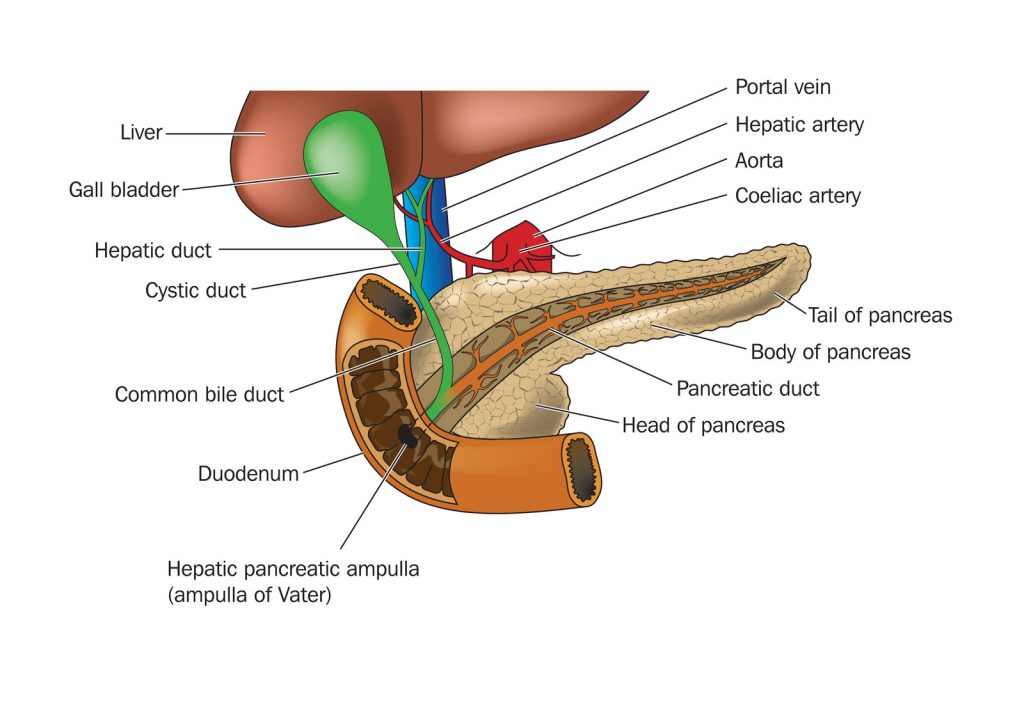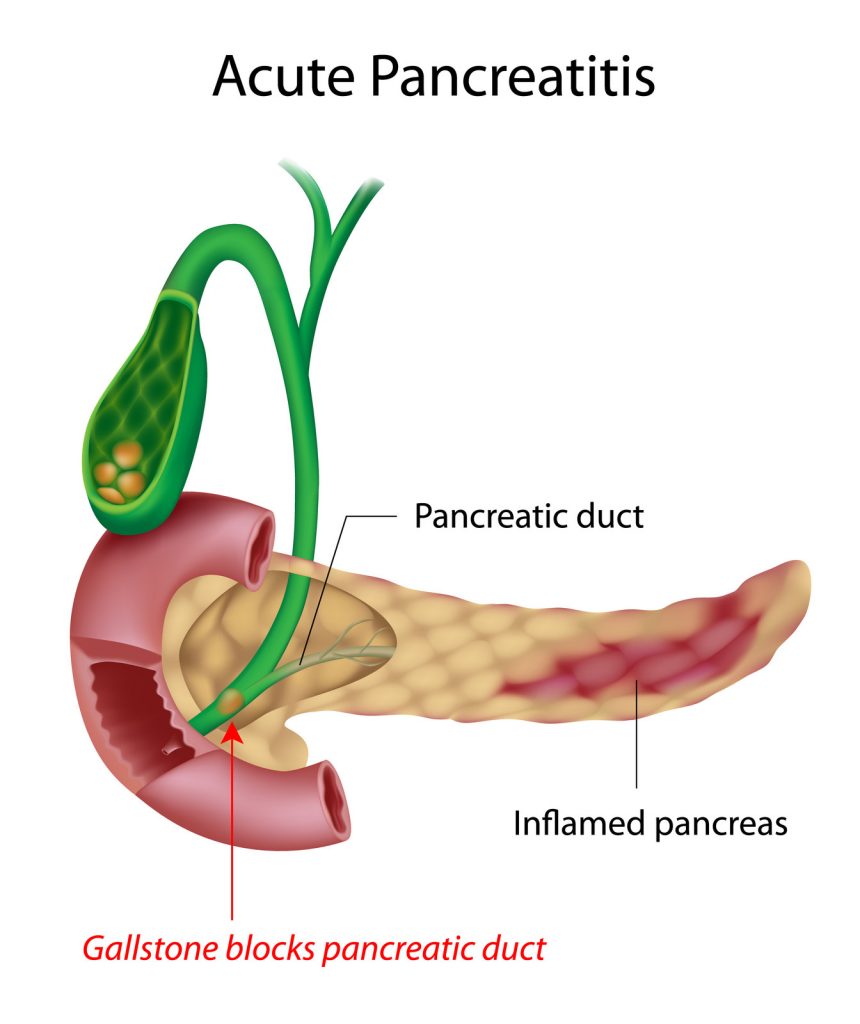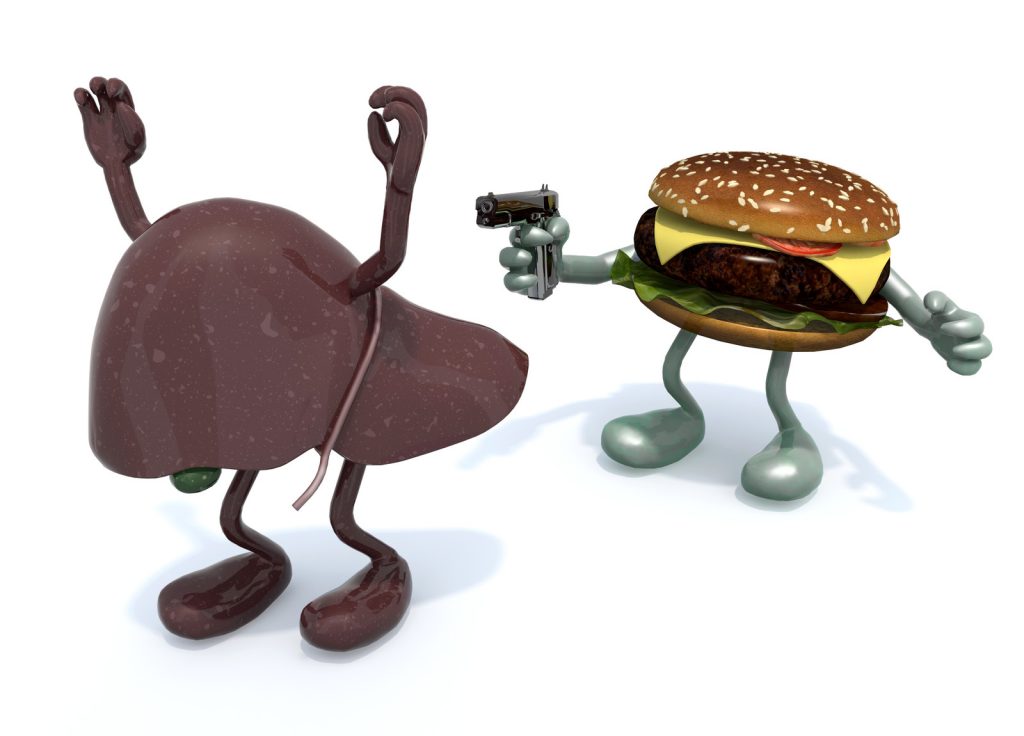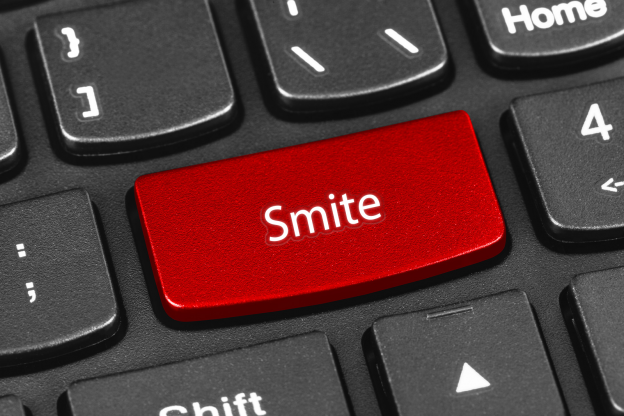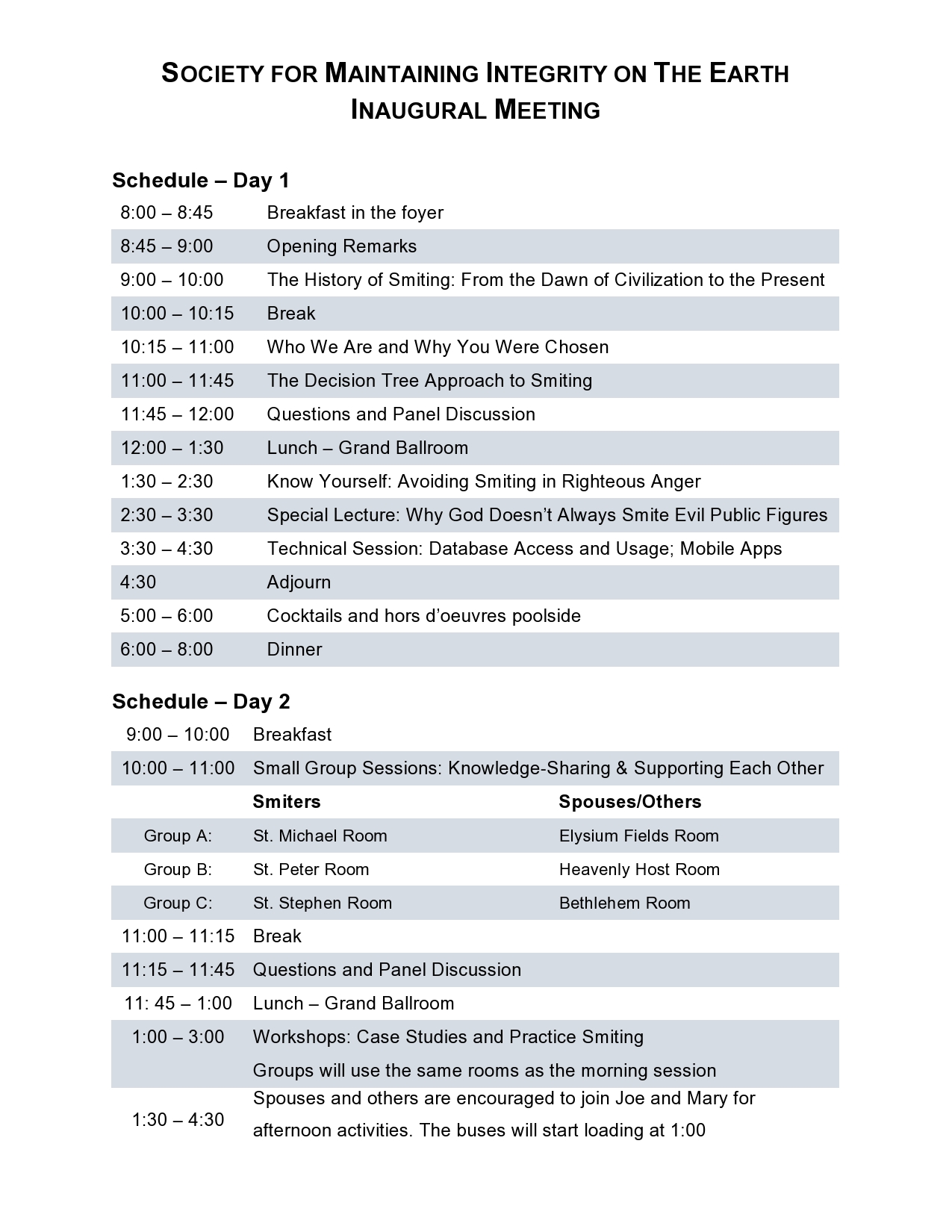It’s been a little more than two months since Baxter crossed the Rainbow Bridge. We miss his furry little face every day, but we have so many memories of him to ease the pain.
The Early Years
Baxter was a very smart puppy. We took him to an obedience class at Pet Smart soon after we got him. He impressed the trainer, learning the commands quickly while the other dogs seemed to struggle, although the training treats were a great incentive. He learned the usual tricks – sit, high-five, shake hands – and every new visitor to our house was an opportunity to show off.
Peg taught him some unique tricks, like “let us pray” and “sign of peace” so he could join Sunday Mass on the television. I taught him “Bang, you’re dead,” which he did with a dramatic flair. Then I’d tell him to roll over and give him two treats for an Oscar-worthy performance. One trick he never learned was “put your toys back into your crate,” no matter how many times Peg tried. He’d look at her as if to say, “Why should I? That’s your job!”
Baxter lived with a cat before he came to us and adopted many cat habits. He liked to stretch out on the back of our couch. Sometimes when we picked him up from the groomer, we found him on the counter next to Miz Laura’s cat who either tolerated or ignored him.
He got so excited when we took him to the groomer, Miz Laura for “Spa Day.” He’d start squealing and jumping around the car when he realized where we were going. He strained against the leash until we got inside, then ran around in circles when Miz Laura came out to get him. They often let him roam free after his grooming. Miz Laura always put a bandana or necktie around his neck, and he looked really handsome!


He figured out how to get to the island in the middle of the kitchen by jumping from the couch to the dining room table to the counter and then the island. I learned to put meat into the microwave to rest after catching him mere inches from the “spoils of war.” Peg didn’t believe me when I told her about Baxter’s acrobatic feats. “He can’t jump that high!”
Her skepticism bit her in the ass the first Halloween with him. I was out of town on a job and Baxter got into leftover chicken bones she had left on the counter, which led to an emergency visit at the veterinarian’s office and a $300 bill. When she called, I said, “Thank you, Jesus,” having avoided the royal ass-chewing I would have gotten if it was my fault.
He loved sharing our dinner, but we quickly learned he wouldn’t eat his dry dog food nuggets if he got people food first. He didn’t like eating alone, so we’d sit in the family room while he dined, then we’d adjourn to the dining room for his “Taco Bell Fourth Meal.” He’d sit on the floor between us, or he would jump on the dining room chair next to me if the handouts weren’t coming fast enough. He’d jump on the table if he was particularly impatient.
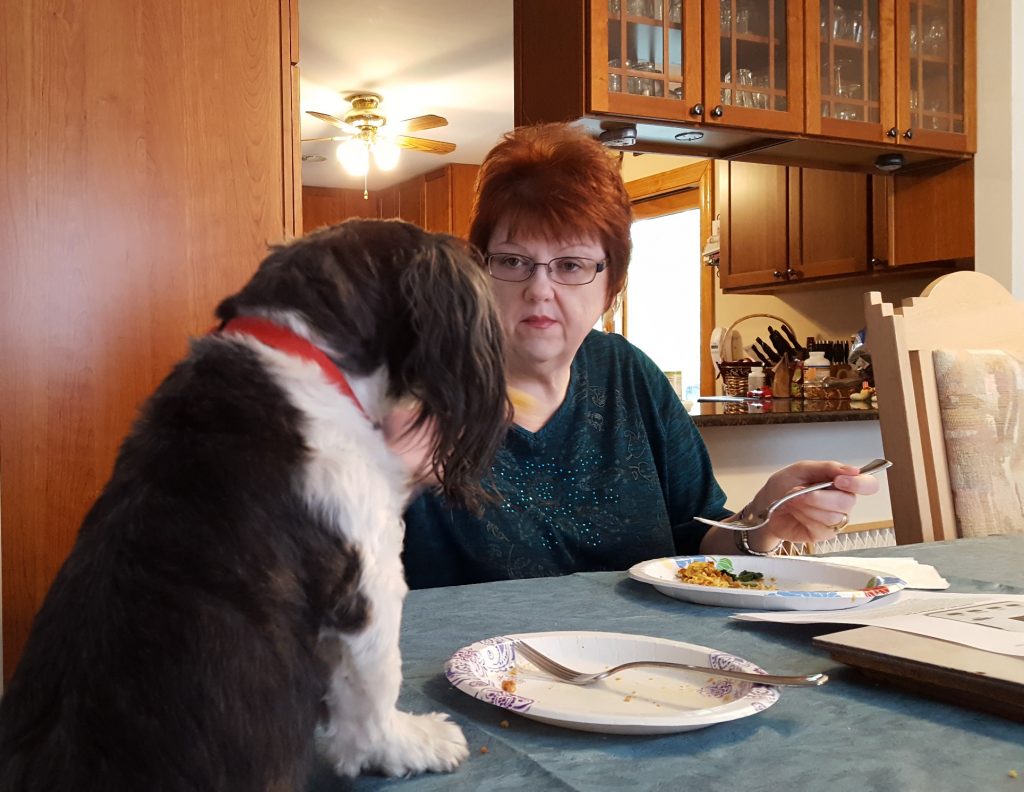
And he was very fast. Once evening he grabbed a stick of butter off the table and flew to the floor before Peg could catch him. Another time he sat on the chair at the far end with his paws on the table while he eyed Peg’s steak intently, calculating his chances of success. I imagined Ennio Morricone’s Spaghetti Western music playing in that little brain.
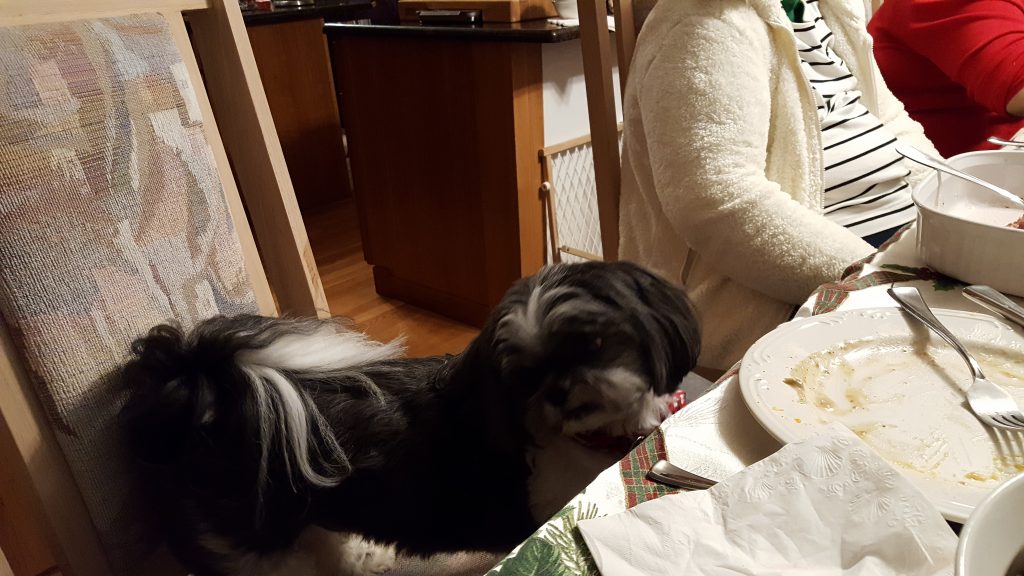
When he got bored with the nuggets, he’d toss a toy into his bowl. Or he’d say, “Fuck the nuggies! I want your food!” We eventually switched to four-dollar-a can dog food, mixing in a bit of dry food for adequate nutrition, but there were still evenings when I ended up tossing it in the trash.
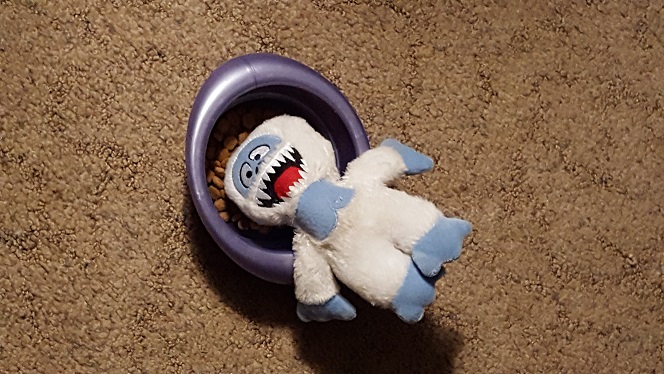
Baxter was a carnivore who loved any kind of meat, but he was especially fond of my brother-in-law’s pulled pork, cooked low and slow on his beloved smoker. One summer the family gathered at our house for pulled pork two Sundays in a row; Baxter thought he’d died and gone to doggie heaven. He was positively miffed when, the next Sunday, the family brought pizza. He gave a snort of disgust and retreated to the family room.
Baxter also loved sweet things like whipped cream, Dairy Queen and Culver’s frozen custard. I’d take him to Dairy Queen in the afternoon and we’d share a soft-serve cone. Usually, he dove into it but sometimes he would wait until the third or fourth offer before remembering, “Oh yeah, I like this stuff.” We often took Baxter with us when we went to Culver’s for a sundae, rewarding him with samples on the way home. He also enjoyed the Pumpkin Shake, available only in October and early November.

Our local grocery store Jewel shares the same parking lot with Culver’s. One evening Peg drove to Jewel to pick up a few things, taking Baxter along for the ride. (If I recall correctly, he ran to the car as soon as Peg opened the door to the garage.) He kept looking at Peg as she drove past Culver’s: “Wait. You’re not going to stop? Why did you bring me in the first place???”
The Guardian of the Cul-de-Sac
The Tibetans bred Shih-Tzus (which translates to “little lion” in Mandarin) from the Pekinese. Pug and Llhasa Apso. The little dogs were initially used to warn the royal court of intruders but later became companions. Baxter appointed himself as our guardian, standing sentinel at the patio door for any riffraff that might pose an imagined threat.
He went ballistic when people walked by and became more incensed if accompanied by a dog, large or small. It didn’t take long for him to figure out that whomever he saw from the patio door would reappear on the other side of the house. He’d run upstairs to the guest room, jump on the bed and continue yelling until they were out of sight. If anyone walked on the sidewalk in front of the house, he’d run back and forth between the guest room and our room, sounding more like a thundering herd of cattle than a fifteen-pound dog.
The Daily Rituals
I took him out to pee every morning and then fed him breakfast, followed by an insulin injection once he became diabetic. He used to demand a walk before I could have coffee, but as he got older, he was content to take the early morning nap, followed by a quick stretch before the late morning nap. We settled into a predictable routine which included daily afternoon recreation.
He loved car rides. When he wanted one, he would stare at me or jump onto the couch and paw my hand. If I asked, “Would you like a car ride” he would bark and go to the back door. Sometimes he’d run to the car if I opened the door to take the garbage out. Occasionally he’d try to con me into a ride at 11:00pm. Sometimes he’d get lucky, and I’d indulge him since a short trip around the neighborhood was enough.
He liked going for walks up to the playground near our house and back. I started taking him to another park after he yanked a muscle in his neck playing “whose dick is bigger” with the dog behind the neighbor’s fence. He couldn’t see her but knew she was there. That turned into a midnight visit to the emergency vet during COVID.
The Nightly Rituals
Baxter wanted to go upstairs at 5pm during the winter because it was dark and, in his mind, time for bed. We resorted to putting up a gate in the hall because otherwise he would run upstairs and start barking for us to join him. He’d reluctantly stay with us if we were watching television, but his patience ran out around 9pm, when he started pulling my socks off with his teeth.
I started eating a mozzarella stick at bedtime to keep my fasting blood sugar at a reasonable level; Baxter soon expected me to share. Our nighttime ritual evolved into a protein snack, several Old Mother Hubbard cookies, a drink of water and four pieces of Pill Pockets. If Peg wasn’t fast enough with the Pill Pockets, he climbed on her and tried to snatch the bag out of her fingers. His attitude towards cookies was, “We’re done when I say we’re done!” One night when he started barking for more Peg told him, “You’ve had enough!” The little shit then jumped off the bed, ran downstairs to one of his many stashes, brought a cookie back to the bedroom and devoured it while looking directly at Peg.
He slept at the foot of our bed, but I would move him closer to us before we went to sleep so he wouldn’t roll off the end. He growled but never opened his eyes. He used to love curling up in bed under my chin when it was cold; I’d listen to little puppy snores through the night. If he woke up before me, he would stare at me, willing me to get up.
Toys
Baxter loved ripping the appendages off his favorite stuffed toys. He went through several Gorillas and Dragons. He liked to pull the stuffing out of Panda and ripped out Peg’s repairs several times. He had a pink rabbit who, after having his ears and legs torn asunder, became a blob we nicknamed “Stinky Bunny,” well-marinated with doggy saliva. We tried to send Stinky Bunny to the farm upstate, but Baxter managed to rescue him from the trash.

Flying Bear was another favorite toy. He loved to grab it with his teeth and whip it back and forth. We tried to find a replacement when Flying Bear became overly ripe, but didn’t have any luck.
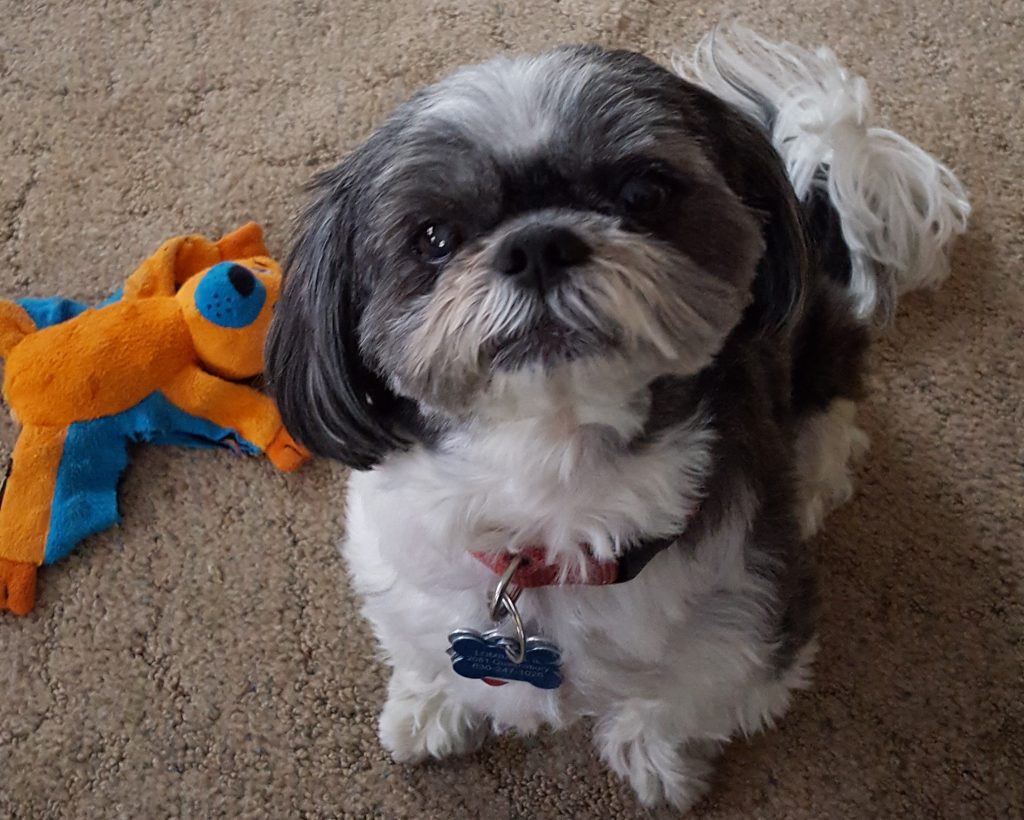
Quirks
He liked to lay on the couch’s footrest and watch television with us; he’d lay very still and stare intently. Sometimes the only way I knew he was still awake was when his ears would twitch. But several things would set him barking at the screen while jumping against the entertainment center:
- The Buick jingle
- Any program in black and white
- Black people on TV (though not in person)
- Animated films (Peg gave up trying to watch Disney’s Brave because he’d go berserk)
- Animals on TV, even if he’d never seen one in person.
When I left for a job, he would put several of his toys on my office chair or in my spot on the couch. I guess he was keeping my spot warm. When I came back from Springfield, he knew when I was about 15 minutes from home, because he’d sit by the door to the garage. Peg called me and we’d count down the streets until I pulled into the garage. Sometimes he and I would bark at each other over the phone.
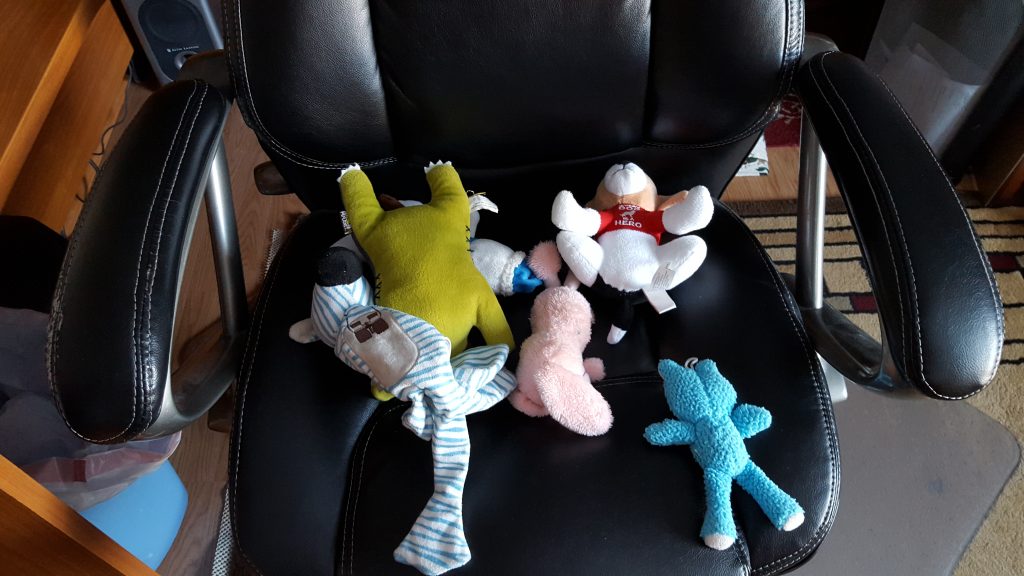
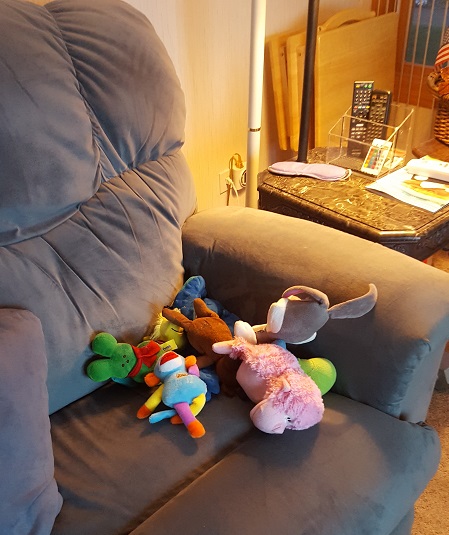
I learned to devote the day of my return from a job to the happy homecoming and indulge his every wish/demand. “Your ass is mine!” We had to go for a walk or a car ride IMMEDIATELY! I had to walk him for a walk every morning before he would let me work in my office.
Later years
Baxter liked to greet anyone coming into the house until he got older. Then he’d run upstairs, coming down only when he thought it was time for people to leave. He turned into a grumpy old fart like his daddy.
Baxter couldn’t easily get up on the bed in the guest room to survey his kingdom the last year he was with us, so he spent his time in a day bed on the floor in Peg’s office. He developed some quirky habits like scratching anything that struck his fancy: the filing cabinet; a binder on the floor; the trash can. Sometimes he would drag a piece of paper off one of the numerous piles on the floor and shred it. Peg would yell, “Stop that!” He’d give her that “What?” look and then resume digging, sometimes deliberately looking at her. He started knocking over a box of beef sticks under Peg’s desk. She would put them back in the box and he’d knock it over again. Eventually, she gave up.
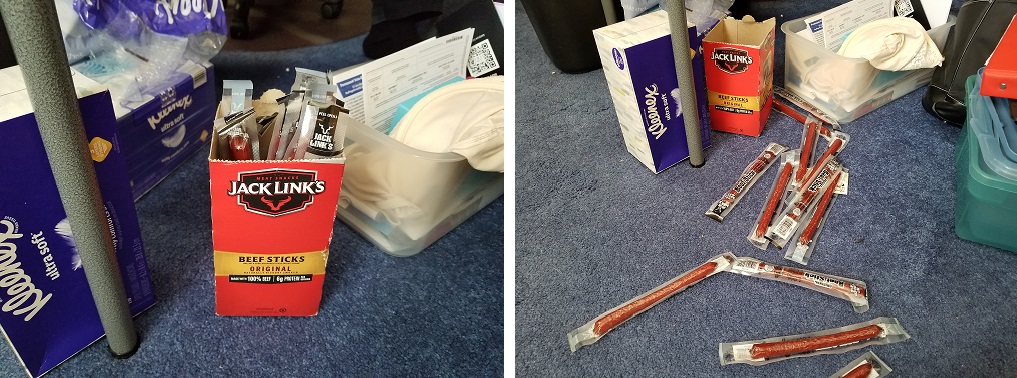
Sometime during the summer, he developed the habit of wandering down the hallway like the night watchman before he finally settled down. He didn’t want to sleep on the bed with us, so I bought another doggy bed for our room. Some nights he preferred the bed in Peg’s office.
I think the most remarkable thing about dogs is they live in the moment. They don’t appear to grouse about getting older and I don’t think they ever contemplate mortality. Every day is a good day, even when it isn’t.


